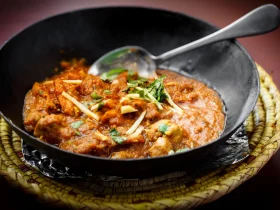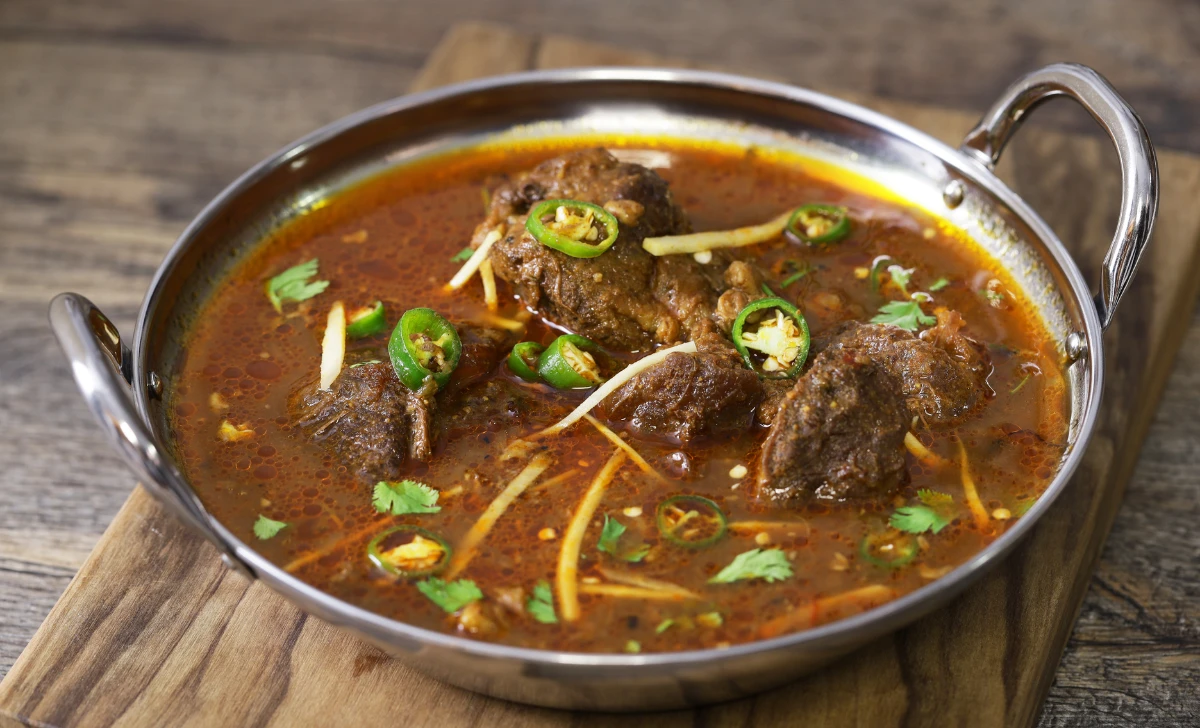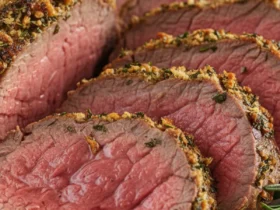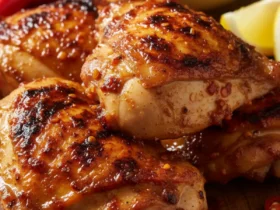Mutton Nihari is a flavorsome and richly spiced slow-cooked meat dish that originated in the Indian subcontinent. It is a popular delicacy in South Asian cuisine, especially in India and Pakistan. The word “Nihari” is derived from the Arabic word “Nahar,” which means “morning” or “daytime.” Traditionally, Nihari was prepared overnight and eaten as a hearty breakfast to provide energy throughout the day. In this article, we will explore the recipe for Mutton Nihari, its origins, cooking method, serving suggestions, and health benefits.
[ez-toc]
History
Mutton Nihari has a rich history that can be traced back to the Mughal era in the Indian subcontinent. The dish originated in the royal kitchens of Awadh (present-day Uttar Pradesh, India) during the reign of the Mughal Empire. It was created as a sumptuous and flavorful dish to cater to the sophisticated palates of the Mughal emperors and the nobility.
The word “Nihari” is derived from the Arabic word “Nahar,” which means “morning” or “daytime.” Traditionally, Nihari was prepared overnight and consumed as a hearty breakfast by the Mughal aristocracy. It was believed that the slow-cooked meat would provide them with sustenance and energy throughout the day.
During the Mughal rule, Awadh was renowned for its elaborate and extravagant culinary culture. The royal chefs in Awadh were known for their culinary mastery and introduced several dishes that still hold a significant place in Indian and Pakistani cuisines. Mutton Nihari was one such dish that became popular not only among the nobility but also among the common people.
As time passed, Mutton Nihari gained popularity and spread beyond the confines of the royal court. It made its way into the kitchens of common households, where it was prepared on special occasions and family gatherings. The dish became a symbol of hospitality and grand feasts, often served to guests as a mark of respect and warm welcome.
With the migration of people from the Awadh region to various parts of the Indian subcontinent, Mutton Nihari took on different regional variations. Each region added its own unique touch to the dish, adapting it to local tastes and preferences. In Pakistan, especially in Karachi and Lahore, Mutton Nihari gained immense popularity and became a staple dish in the local cuisine.
Today, Mutton Nihari is celebrated as a culinary masterpiece, treasured for its depth of flavors and tender, melt-in-your-mouth meat. It continues to be a beloved dish in South Asian cuisine, often prepared with passion and served with pride. Whether enjoyed in the comfort of home or savored in restaurants specializing in traditional cuisine, Mutton Nihari remains a testament to the rich culinary heritage of the region.
Time
| Step | Time |
|---|---|
| Preparing the Meat | 10 minutes |
| Preparing the Spice Mix | 5 minutes |
| Cooking the Nihari | 4-5 hours |
| Thickening the Gravy (Optional) | 15-20 minutes |
Please note that the cooking and preparation times mentioned above are approximate and can vary based on factors such as the quantity of meat, heat intensity, and personal cooking preferences. It’s important to adjust the cooking time accordingly and check for the desired tenderness of the meat while simmering the Nihari.
Ingredients
| Ingredients | Quantity |
|---|---|
| Mutton (bone-in pieces) | 500 grams |
| Onions | 1 large |
| Ghee or Cooking Oil | 2 tablespoons |
| Ginger Paste | 1 tablespoon |
| Garlic Paste | 1 tablespoon |
| Wheat Flour (optional) | 1 tablespoon |
| Salt | To taste |
| Water | As required |
| Red Chili Powder | 1 teaspoon |
| Turmeric Powder | 1/2 teaspoon |
| Coriander Powder | 1/2 teaspoon |
| Cumin Powder | 1/2 teaspoon |
| Garam Masala Powder | 1/2 teaspoon |
| Fennel Seeds | 1/2 teaspoon |
| Green Cardamom Pods | 2-3 |
| Black Cardamom Pods | 1-2 |
| Cloves | 2-3 |
| Cinnamon Stick | 1/2 inch |
| Bay Leaves | 1-2 |
| Nutmeg Powder | A pinch |
| Mace Powder | A pinch |
| Fresh Coriander Leaves | For garnish |
| Ginger Slices | For garnish |
| Fried Onions | For garnish |
| Lemon Wedges | For garnish |
Note: The above quantities are based on a serving size for 2 people. Adjust the quantities accordingly if you need to serve more or fewer people.
Directions
- Preparing the Meat:
- Clean the mutton pieces thoroughly and trim off any excess fat.
- Wash the meat with cold water and pat it dry.
- Set the meat aside while you prepare the spice mix.
- Preparing the Spice Mix:
- In a small bowl, mix together the red chili powder, turmeric powder, coriander powder, cumin powder, garam masala powder, fennel seeds, green cardamom pods, black cardamom pods, cloves, cinnamon stick, bay leaves, nutmeg powder, and mace powder.
- Set aside the spice mix for later use.
- Cooking the Nihari:
- Heat ghee or cooking oil in a large, heavy-bottomed pot or a pressure cooker over medium heat.
- Add the sliced onions and cook until golden brown.
- Add ginger paste and garlic paste, and sauté for a few minutes until the raw smell disappears.
- Adding the Meat:
- Add the mutton pieces to the pot and cook on high heat for a few minutes until they are browned on all sides. This step helps seal in the juices and enhances the flavors of the meat.
- Adding the Spice Mix:
- Reduce the heat to low and add the prepared spice mix to the pot.
- Mix well to coat the meat evenly with the spices.
- Cook for a minute or two to toast the spices and release their flavors.
- Adding Water and Cooking:
- Add enough water to cover the meat completely.
- Add salt according to your taste.
- If using a pressure cooker, close the lid and cook on low heat for about 45 minutes to 1 hour, or until the meat is tender and cooked through.
- If using a pot, cover it with a tight-fitting lid and simmer on low heat for 3-4 hours, stirring occasionally.
- Thickening the Gravy (Optional):
- If you prefer a thicker gravy, mix wheat flour with some water to make a smooth paste.
- Add this paste to the Nihari and cook for an additional 15-20 minutes, stirring continuously, until the gravy thickens.
- Serve and Garnish:
- Once the meat is tender and the flavors have melded together, your Mutton Nihari is ready to be served.
- Garnish the Nihari with fresh coriander leaves, ginger slices, fried onions, and a squeeze of lemon juice for added freshness and flavor.
- Serve the Nihari hot, accompanied by naan or rice.
- Nihari pairs well with yogurt raita (yogurt-based side dish) and pickles.
- You can also serve it with a side of sliced onions and green chilies for a tangy kick.
Equipment Required
Nutrition Information
| Nutrition Information | Amount per Serving |
|---|---|
| Serving Size | 1 plate (approx. 250g) |
| Calories | 450 |
| Total Fat | 25g |
| – Saturated Fat | 10g |
| Cholesterol | 110mg |
| Sodium | 500mg |
| Total Carbohydrate | 15g |
| – Dietary Fiber | 3g |
| – Sugars | 2g |
| Protein | 40g |
| Vitamin D | 4.5mcg |
| Calcium | 70mg |
| Iron | 5.5mg |
| Potassium | 600mg |
| Vitamin C | 5mg |
Please note that the nutrition information provided is approximate and can vary based on the specific ingredients and portion sizes used in the recipe. It’s always advisable to calculate the nutritional values based on the actual ingredients and quantities used.
Tips
- Use bone-in mutton pieces for enhanced flavor and tenderness.
- Marinating the mutton in yogurt and spices for a few hours before cooking can further enhance the taste.
- Slow cooking is key to achieving the perfect texture and flavors in Nihari. Allow the meat to simmer on low heat for a longer duration for the best results.
- While toasting the spice mix, be careful not to burn them. Stir continuously and cook for a short duration to release the flavors without scorching.
- If you prefer a thicker gravy, you can increase the quantity of wheat flour paste for additional thickness.
- Nihari tastes even better when reheated the next day, allowing the flavors to further develop and meld together.
- Adjust the spice levels according to your preference. If you prefer a milder Nihari, reduce the quantity of red chili powder or omit it altogether.
- Experiment with garnishes to add your own touch to the dish. You can try adding thinly sliced fried onions, a dollop of yogurt, or a sprinkle of roasted cumin seeds for added texture and flavor.
Pros & Cons
| Pros | Cons |
|---|---|
| ✔️ Bursting with Flavor | ❌ Long Cooking Time |
| ✔️ Rich and Aromatic Gravy | ❌ Requires Patience and Time |
| ✔️ Tender and Melt-in-Your-Mouth | ❌ High in Fat and Calories |
| ✔️ Versatile for Pairing | ❌ Not Suitable for Vegetarians |
| ✔️ Represents Culinary Heritage | ❌ May Require Some Special Spices |
Conclusion
Mutton Nihari is a culinary gem that brings together the rich heritage of South Asian cuisine with its burst of flavors and tender meat. This slow-cooked delicacy is a testament to the skill and expertise of the Mughal chefs who crafted this dish centuries ago.
With its aromatic spices, rich gravy, and melt-in-your-mouth meat, Mutton Nihari promises a truly delightful culinary experience. The dish carries a depth of flavors that will transport you to the royal kitchens of Awadh, where it originated.
While Mutton Nihari does require time and patience, the end result is well worth the effort. The slow cooking process allows the meat to become tender and imbibe the flavors of the spices, resulting in a dish that will leave your taste buds longing for more.
Whether you choose to pair it with naan or rice, garnish it with fresh coriander leaves and ginger slices, or customize it with your favorite variations, Mutton Nihari offers a world of possibilities to satisfy your cravings and impress your guests.
So, why not embark on this culinary adventure and savor the exquisite flavors of Mutton Nihari? Gather the ingredients, embrace the slow cooking process, and let the aromas fill your kitchen. Indulge in this flavorful masterpiece that represents the cultural heritage and culinary excellence of the Indian subcontinent.
Give Mutton Nihari a try, and you’ll discover why this dish has stood the test of time and continues to captivate the hearts and palates of food enthusiasts around the world. Unleash your inner chef and embark on a journey of flavors that will leave you craving more with every bite.
Facts
- Fiery Origins
- Did you know that Mutton Nihari was originally prepared for the Mughal emperors? Its intense flavors and spices were believed to provide them with strength and vigor to face the day ahead.
- 🕰️ Slow and Steady
- Mutton Nihari is a labor of love that requires hours of slow cooking. Its long cooking time allows the meat to become tender and lets the flavors intensify, resulting in a dish that is worth the wait.
- 👑 A Royal Affair
- Mutton Nihari was once a dish exclusively enjoyed by the royal families and nobility. Today, it has transcended social boundaries and become a beloved part of South Asian cuisine, delighting people from all walks of life.
- 💫 Spice Medley
- The spice mix used in Mutton Nihari is a magical blend of aromatic spices like cinnamon, cardamom, cloves, and more. These spices not only infuse the dish with a captivating aroma but also lend it a complex and tantalizing flavor profile.
- 🍽️ Perfect Pairings
- Mutton Nihari pairs exceptionally well with naan, rice, or roti. Its rich and flavorful gravy begs to be soaked up by a warm, freshly baked piece of naan, creating a heavenly combination that will transport your taste buds to culinary paradise.
FAQ’s
What is the best cut of meat to use for Mutton Nihari?
The best cut of meat for Mutton Nihari is bone-in mutton, such as shoulder or leg pieces. The bones add flavor and help in achieving tender meat.
Can I make Nihari with chicken instead of mutton?
Yes, you can make Nihari with chicken instead of mutton. Simply replace the mutton with bone-in chicken pieces and adjust the cooking time as chicken cooks faster than mutton.
How long does it take to cook Mutton Nihari?
The cooking time for Mutton Nihari can vary depending on the cooking method. In a pressure cooker, it takes approximately 45 minutes to 1 hour. In a pot, it takes around 3-4 hours on low heat for the meat to become tender and flavorful.
Can I make Mutton Nihari in a slow cooker?
Yes, you can make Mutton Nihari in a slow cooker. Follow the same steps for preparation and browning the meat, then transfer everything to the slow cooker. Cook on low heat for 6-8 hours or until the meat is tender.
Is Mutton Nihari spicy?
Mutton Nihari is traditionally a spicy dish. However, you have control over the spice level. You can adjust the amount of red chili powder or omit it if you prefer a milder version.
Can I freeze Mutton Nihari for later use?
Yes, you can freeze Mutton Nihari for later use. Allow it to cool completely, portion it into airtight containers, and store in the freezer for up to 3 months. Thaw in the refrigerator before reheating.
What are some side dishes that pair well with Mutton Nihari?
Mutton Nihari pairs well with naan (Indian bread), rice, or roti (Indian flatbread). It also goes well with yogurt raita (yogurt-based side dish) and pickles. Sliced onions and green chilies can be served as a tangy accompaniment.
Can I make Mutton Nihari less fatty?
To make Mutton Nihari less fatty, you can skim off excess oil before serving. You can also use leaner cuts of mutton and trim off visible fat from the meat.
Can I prepare the spice mix in advance for convenience?
Yes, you can prepare the spice mix in advance and store it in an airtight container. This can save time during the actual cooking process.
Can I use Nihari masala spice mix instead of making the spice mix from scratch?
Yes, you can use Nihari masala spice mix as a convenient alternative. Follow the instructions on the packet to achieve the desired flavors. Adjust the quantity according to your taste preferences.












Leave a Review